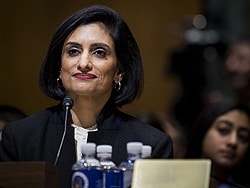Seema Verma, MPH, President Donald Trump's choice to head the Centers for Medicare & Medicaid Services (CMS), has mixed feelings about electronic health record (EHR) systems.
It's just one example of how she's on the same page with many physicians regarding healthcare.
"My doctor…is staring at her computer instead of looking at me," the healthcare policy consultant told the US Senate Committee on Finance during her confirmation hearing yesterday.

Seema Verma, CMS administrator nominee for President Trump, smiles during a Senate Finance Committee hearingWashington, DC, on Thursday, February 16, 2017. Source: Pete Marovich/Bloomberg/Getty Images
This is just one example of how provider's recommendations have been purposefully neglected in regard to electronic health records. The energy of a vast HIT niche have been misappropriated by HHS and CMS in an undisguised effort to harness EHRs for their own interest to collect data. Little if any effort has been made to the entology of the EHR, or its effectiveness in day to . day activities of providers. Neither has any oversight or guidance to its usability or efficacy in patient care.
It will take some time and effort to reverse the march toward a singularity of patient care and HIT.
Donald Trump is listening to experts in most areas of government management, including health care management and reform. Billions of dollars have been spent for HIT, at least half of which has been wasted. The well known incentives were given to providers who could ill afford the huge IT expenditures. Without that infusion of capital it is doubtful if the IT transformation would have occured. The special interest group here is the IT hardware and software developers. Huge EHR firms such as Cerner, Epic and others profitted greatly.
Verma's comment came in response to a question about the future of the CMS incentive program for meaningful use of EHRs, much criticized by physicians for turning them into data entry clerks. She also recounted seeing signs in physician waiting rooms that apologized for schedule delays due to EHR implementation. Yet another tech challenge she cited was the lack of EHR interoperability, which prevents different programs from freely exchanging data.
"We need to make sure [EHR technology] is fulfilling its promise and not being more burdensome," said Verma.
Other 'key elements" will effect Regulations, Mandatory Medicare Pilot Projects,(most of which have failed), and not vetted prior to implementation. Medicare Financial Risk (imposed by a negative incentive to diminish rembursement to providers who do not participate in QA measures.
Verma has some fresh approaches to Medicaid and funding HSA accounts.
She is the architect, for example, of a "consumer-directed" Medicaid program called Healthy Indiana Plan (HIP), which gives beneficiaries there something akin to a health savings account — a Personal Wellness and Responsibility (POWER) account — to apply toward a $2500 deductible. Verma also helped create
HIP 2.0, which expanded Medicaid coverage in the state under the ACA with the help of federal dollars.
Launched in 2015 when Vice President Mike Pence was Indiana's governor, HIP 2.0 requires beneficiaries to contribute 2% of their income to their POWER (a Personal Wellness and Responsibility (POWER) account each month. That skin-in-the-game entitles them to extra benefits such as dental and vision coverage.
It remains to be seen if those with limited income do have the financial capacity to contribute 2% especially if there will be copays.
The Congressional Approval Process is in motion
While Senate Democrats appeared vexed at times with Verma, Republicans, who control the Finance Committee, praised her. "We have an outstanding nominee in front of us," said Sen. Michael Enzi (R-WY). "You haven't just studied Medicaid and Medicare; you've done things."
"You have acquitted yourself very well," added Sen. Orrin Hatch (R-UT), the committee chair.
The next step in the confirmation process is for the committee to send Verma's nomination to the full Senate for a final vote.
All in all the changes which may come are encouraging to most.
Trump Pick for CMS Would Ease Up on Physicians









